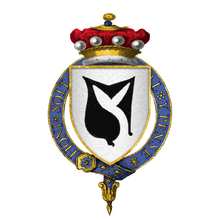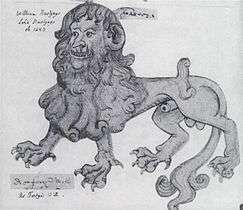William Hastings, 1st Baron Hastings
| The Right Honourable The Lord Hastings KG | |
|---|---|
 Arms of Sir William Hastings, 1st Baron Hastings, KG | |
| Spouse(s) | Katherine Neville |
|
Issue
Edward Hastings, 2nd Baron Hastings Sir William Hastings Sir Richard Hastings George Hastings Anne Hastings, Countess of Shrewsbury Elizabeth Hastings | |
| Noble family | Hastings |
| Father | Sir Leonard Hastings |
| Mother | Alice Camoys |
| Born | c.1431 |
| Died |
13 June 1483 Tower of London |

William Hastings, 1st Baron Hastings KG (c. 1431 – 13 June 1483) was an English nobleman. A follower of the House of York, he became a close friend and one of the most important courtiers of King Edward IV, whom he served as Lord Chamberlain. He was executed on charges of treason by Edward's brother and ultimate successor, Richard III.
Biography

William Hastings, born about 1431, was the eldest son of Sir Leonard Hastings (c.1396 – 20 October 1455), and his wife Alice Camoys, daughter of Thomas de Camoys, 1st Baron Camoys.[1][2][lower-alpha 1] Hastings succeeded his father in service to the House of York and through this service became close to his distant cousin the future Edward IV, whom he was to serve loyally all his life. He was High Sheriff of Warwickshire and High Sheriff of Leicestershire in 1455.
He fought alongside Edward at the Battle of Mortimer's Cross and was present at the proclamation of Edward as king in London on 4 March 1461 and then when the new king secured his crown at the Battle of Towton shortly thereafter. He was knighted on the field of battle. With the establishment of the Yorkist regime, Hastings became one of the key figures in the realm, most importantly as Master of the Mint and Lord Chamberlain, an office he held for the duration of the reign and which made him one of the most important means of access to the king. He was also created Baron Hastings, a title reinforced by grants of land and office, primarily in Leicestershire and Northamptonshire. In 1462 he was invested as a Knight of the Garter.
In 1474, he was awarded royal licence to crenellate at three of his landholdings in Leicestershire; at Ashby-de-la-Zouch, Kirby Muxloe, and at Bagworth. He built extensively at Ashby, mostly making additions to the pre-existing manor house built by the de la Zouch family in the thirteenth century. His greatest achievement at Ashby was, of course, the Hastings Tower – an imposing and thoroughly impressive creation. At Kirby Muxloe Castle he began an intricate and beautiful fortified house of red brick, one of the first of its kind in the county. Thanks to English Heritage, the castles at Ashby and Kirby can still be seen, but regrettably nothing survives to indicate any construction at Bagworth.
His importance in these years is recorded in a number of sources and was recognised by the greatest peer in the realm, Richard Neville, Earl of Warwick. In 1462, Warwick arranged for Hastings to marry his widowed sister, Katherine Neville. (Katherine's first husband, Lord Bonville, had been killed at St Albans in 1461 ; their infant daughter, Cecily, succeeded to the Bonville titles and estates.)[12][13][14]
Despite this matrimonial relationship with the Nevilles, when Warwick drove Edward IV into exile in 1470, Hastings went with Edward and accompanied the king back the following spring. Hastings raised troops for Edward in the English Midlands and served as one of the captains of the Yorkist forces at both Barnet and Tewkesbury.
His service, loyalty, and ability, along with the fall of his Neville in-laws, made Hastings even more important during the second half of Edward IV's reign. He continued to serve as Chamberlain and was awarded the position of Chamberlain of the Exchequer in 1471, which he held until 1483. He was also appointed Lieutenant of Calais, which made him an important player in foreign affairs, and given authority over an increasingly large section of the English Midlands. At court, he was involved in two lengthy feuds with members of Queen Elizabeth Woodville's family, most notably with her son Thomas Grey, first Marquess of Dorset.
After the death of Edward IV on 9 April 1483, the dowager queen sought to monopolise political power for her family by appointing family members to key positions and rushing the coronation of her young son Edward V as king, thereby circumventing Richard, Duke of Gloucester, whom the late king had appointed Lord Protector. Hastings was a key figure in checking these manoeuvres. While keeping the Woodvilles in check in London, Hastings informed Richard of their proceedings and asked him to hasten to London. Richard intercepted the young king, who also was on his way to London, with his Woodville relatives. Hastings then supported Richard's formal installation as Lord Protector and collaborated with him in the royal council.
Affairs changed dramatically on 13 June 1483 during a council meeting at the Tower of London: Richard, supported by the Duke of Buckingham, accused Hastings and other council members of having conspired against his life with the Woodvilles, with Hastings's mistress Jane Shore (formerly also mistress to Edward IV and Dorset), acting as a go-between. While other alleged conspirators were imprisoned, Hastings was immediately beheaded in the courtyard.
The execution of the popular Hastings was controversial among contemporaries and has been interpreted differently by historians and other authors: while the traditional account, harking back to authors of the Tudor period including William Shakespeare, considered the conspiracy charge invented and merely a ploy to remove Hastings, who was too formidable an obstacle to Richard's royal ambitions,[15] others have been more open to the possibility of such a conspiracy and that Richard merely reacted to secure his position.[16] Some authors have conceded the possibility of a conspiracy, but think it was a response to Richard's grasp for the throne.
Richard did not issue an attainder against Hastings and his family. Hence his wife and sons were allowed to inherit his lands and properties. Hastings himself was buried in the north aisle of St George's Chapel, Windsor, next to Edward IV.[17]
In literature
He is portrayed in Shakespeare's Richard III.
Family
Hastings married, before 6 February 1462,[17] Katherine Neville, sister of Richard Neville, Earl of Warwick—known as "Warwick the Kingmaker"—and widow of William Bonville, 6th Baron Harington, slain at the Battle of Wakefield on 30 December 1460, by whom he had had four sons and two daughters:[12][13][14]
- Edward Hastings, 2nd Baron Hastings, who married Mary Hungerford.[18][19]
- Sir William Hastings.[13]
- Sir Richard Hastings, who married, and had two daughters and coheirs, Elizabeth Hastings, who married John Beaumont of Gracedieu, Leicestershire, Master of the Rolls, and Mary Hastings, who married Thomas Saunders of Harringworth, Northamptonshire.[13][20]
- George Hastings.[13]
- Anne Hastings, who married her father's ward, George Talbot, 4th Earl of Shrewsbury.[13]
- Elizabeth Hastings.[13]
Notes
- ↑ Sir Leonard Hastings (c.1396 – 20 October 1455) was a member of the English gentry who moved his seat to Leicestershire from Yorkshire where the family had long been established. His wife was Alice Camoys, daughter of Thomas de Camoys, 1st Baron Camoys, and his first wife, Elizabeth Louches, the daughter and heiress of William Louches.[1][2]
Sir Leonard Hastings had three other sons and three daughters:[2][3][4]
- Richard Hastings, Baron Welles (d.1503), also styled Lord Willoughby, who married firstly, before 1 June 1470 Joan Welles, only daughter of Richard de Welles, 7th Baron Welles, by his first wife, Joan Willoughby, only daughter of Robert Willoughby, 6th Baron Willoughby de Eresby, and secondly Joan Romondbye (d. 20 March 1505), widow of Richard Pigot, (died c. 15 April 1483), Serjeant-at-law.[5][6][7][8][9]
- Sir Ralph Hastings (d.1495) of Harrowden, Northamptonshire, who married Amy Tattershall, daughter and heiress of John Tattershall, esquire, of Woolwich, Kent, and Wanstead, Essex, by whom he had six daughters.[5][10]
- Thomas Hastings.
- Elizabeth Hastings (c.1450 – 1508), who married, before 1465, Sir John Donne (1450–1503) of Kidwelly, Carmarthenshire, third son of Griffith Donne of Kidwelly by Janet, daughter of Sir John Scudamore, and by him had two sons, Sir Edward Donne (c.1482 – 1552) and Sir Griffith Donne (c.1487 – 1543), and two daughters, Anne Donne (c.1471 – c. 1507), who was the first wife of Sir William Rede of Boarstall, Buckinghamshire, and Margaret Donne (born c.1480), who married Edward Trussell (c.1478 – 16 June 1499) of Elmesthorpe, and was the mother of Elizabeth Trussell (1496–1527), wife of John de Vere, 15th Earl of Oxford.[11]
- Anne Hastings, who married Thomas Ferrers, esquire.[5]
- Joan Hastings, who married John Brokesby, esquire.[5]
- 1 2 Richardson I 2011, pp. 398–9.
- 1 2 3 Richardson II 2011, pp. 369–71.
- ↑ Richardson IV 2011, pp. 306–7.
- ↑ Acheson 1992, p. 234.
- 1 2 3 4 Richardson II 2011, p. 369.
- ↑ Richardson IV 2011, pp. 307–8.
- ↑ Burke 1831, p. 562.
- ↑ Cokayne 1959, p. 447.
- ↑ Cokayne 1959, p. 668.
- ↑ Nicolas 1836, p. 421.
- ↑ Richardson II 2011, p. 370.
- 1 2 Horrox 2004.
- 1 2 3 4 5 6 7 Richardson II 2011, p. 371.
- 1 2 Nicolas 1826, pp. 368–75.
- ↑ For instance, Alison Weir, The Princes in the Tower, London: Random House, 1992.
- ↑ For instance, Paul Murray Kendall, Richard III.
- 1 2 Cokayne 1926, p. 373.
- ↑ Richardson II 2011, pp. 371–2.
- ↑ Cokayne 1926, p. 374.
- ↑ Nicolas 1826, p. 373.
References
- Acheson, Eric (1992). A Gentry Community; Leicestershire in the Fifteenth Century, c.1422-c.1485. Cambridge: Cambridge University Press. Retrieved 6 October 2013.
- Burke, John (1831). A General and Heraldic Dictionary of the Peerages of England, Ireland and Scotland, Extinct, Dormant and in Abeyance. London: Henry Colburn. Retrieved 6 October 2013.
- Cokayne, George Edward (1926). The Complete Peerage, edited by Vicary Gibbs. VI. London: St. Catherine Press.
- Cokayne, George Edward (1959). The Complete Peerage, edited by Geoffrey H. White. XII, Part II. London: St. Catherine Press.
- Horrox, Rosemary (2004). "Hastings, William, first Baron Hastings (c.1430–1483)". Oxford Dictionary of National Biography (online ed.). Oxford University Press. doi:10.1093/ref:odnb/12588. (Subscription or UK public library membership required.)
- Nicolas, Nicholas Harris (1826). Testamenta Vetusta. I. London: Nicholas and Son. pp. 368–75. Retrieved 6 October 2013.
- Nicolas, Nicholas Harris (1836). Testamenta Vetusta. II. London: Nicholas and Son. p. 421. Retrieved 7 October 2013.
- Richardson, Douglas (2011). Everingham, Kimball G., ed. Magna Carta Ancestry: A Study in Colonial and Medieval Families. I (2nd ed.). Salt Lake City. ISBN 1-4499-6637-3.
- Richardson, Douglas (2011). Everingham, Kimball G., ed. Magna Carta Ancestry: A Study in Colonial and Medieval Families. II (2nd ed.). Salt Lake City. ISBN 1-4499-6638-1.
- Richardson, Douglas (2011). Everingham, Kimball G., ed. Magna Carta Ancestry: A Study in Colonial and Medieval Families. IV (2nd ed.). Salt Lake City. ISBN 1-4609-9270-9.
Further reading
| Wikimedia Commons has media related to William Hastings, 1st Baron Hastings. |
- Carpenter, Christine. The Wars of the Roses (Cambridge, 1997)
- Dunham, William Huse. Lord Hastings' indentured retainers, 1461–1483 (New Haven, 1955)
- Hancock, Peter A. – Richard III and the Murder in the Tower (2009)
- Horrox, Rosemary. Richard III : a study of service (Cambridge, 1989)
- Kendall, Paul Murray, Richard III, London, Allen & Unwin (1955)
- Ross, Charles. Edward IV (Berkeley, 1974)
- Ross, Charles. Richard III (1981)
- Seward, Desmond. A Brief History of the Wars of the Roses (Robinson, 1995)
| Peerage of England | ||
|---|---|---|
| New title | Baron Hastings 1461–1483 |
Succeeded by Edward Hastings |
| Political offices | ||
| Preceded by The Earl of Salisbury |
Lord Chamberlain 1461–1470 |
Vacant |
| Vacant | Lord Chamberlain 1471–1483 |
Succeeded by The Viscount Lovell |